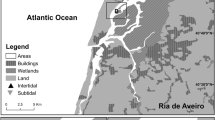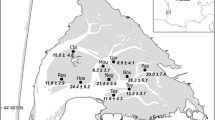Abstract
A restoration programme was introduced in the Mondego Estuary (Portugal) to recover seagrass beds of Zostera noltii endangered by eutrophication. A long-term survey of 10 years was used to assess the development of the processes involved, focusing one of the key species (Cyathura carinata, Isopoda). The mitigation measures implemented since 1998 (nutrient loading reduction, freshwater circulation improvement and seagrass bed protection) enhanced water quality and seagrass recovery, thus preventing the development of macroalgal blooms. C. carinata was resilient to the occurrence of floods and macroalgal blooms, although both events caused dispersion of individuals. This isopod was not much influenced by the changes occurring in the estuary, showing an unalterable population structure during the entire study period. After 1998, its density and biomass became more stable at an inner unvegetated sand flat area, where this isopod was most abundant; its population slightly increased in a bare mud flat at the middle section of the estuary; but it could not establish successfully in a downstream Z. noltii bed, contrarily to other common estuarine species. Apart from other unknown reasons, the disrupted balanced between trematodes and their hosts, caused by the eutrophication processes, may have an important role in the discontinuity of C. carinata at the Z. noltii bed. If the intertidal areas become fully restored to the original seagrass coverage, high prevalence and intensity trematodes may prevent this isopod and other crustaceans from recovering within the intervened areas, by enhancing host mortality and recruitment failure. In order to avoid this kind of situation, it may be necessary to survey the levels of parasite infestation within the target hosts and safeguard areas where crustaceans present healthy populations.






Similar content being viewed by others
References
Amanieu M (1969) Variations saisonnières de la taille et cycle reproducteur à Arcachon de Cyathura carinata (Krøyer). J Exp Mar Biol Ecol 4:79–89
Bamber RN (1985) The autoecology of Cyathura carinata (Crustacea: Isopoda) in a cooling water discharge lagoon. J Mar Biol Assoc UK 65:181–194
Blanchet H, Mountaudouin X, Chardy P, Bachelet G (2005) Structuring factors and recent changes in subtidal macrozoobenthic communities of a coastal lagoon, Arcachon Bay (France). Estuar Coast Shelf Sci 64(4):561–576
Burbanck WD, Burbanck MP (1979) Cyathura (Arthropoda: Crustacea: Isopoda: Anthuridae). In: Hart CW Jr, Fuller SLH (eds) Pollution ecology of estuarine invertebrates. Academic, New York, pp 293–323
Cardoso PG, Brandão A, Pardal MA, Raffaelli D, Marques JC (2005) The resilience of Hydrobia ulvae populations to anthropogenic and natural disturbances. Mar Ecol Prog Ser 289:191–199
Clark JR (1996) Coastal zone management handbook. CRC Press LLC, Boca Raton
Cloern JE (2001) Our evolving conceptual model of the coastal eutrophication problem. Mar Ecol Prog Ser 210:223–253
Dolbeth M, Pardal MA, Lillebø AI, Azeiteiro U, Marques JC (2003) Short- and long-term effects of eutrophication on the secondary production of an intertidal macrobenthic community. Mar Biol 143:1229–1238
Duarte CM (2002) The future of seagrass meadows. Environ Conserv 29:192–206
Ferreira SM, Pardal MA, Lillebø AI, Cardoso PG, Marques JC (2004) Population dynamics of Cyathura carinata (Isopoda) in a eutrophic temperate estuary. Estuar Coast Shelf Sci 61:669–677
Ferreira SM, Jensen KT, Martins PA, Sousa SF, Marques JC, Pardal MA (2005) Impact of microphallid trematodes on the survivorship, growth and reproduction of an isopod (Cyathura carinata). J Exp Mar Biol Ecol 318:191–199
Franklin JF (1989) Importance and justification of long-term studies in Ecology. In: Likens GE (ed) Long-term studies in ecology. Approaches and alternatives. Springer Berlin Heidelberg New York, pp 3–19
Gaschütz G, Pauly D, David N (1980) A versatile basic program for fitting weight and seasonally oscillating length growth data. ICES CM G24:1–23
Hartog C, Phillips RC (2000) Seagrasses and benthic fauna of sediment shores. In: Reise K (ed) Ecological comparisons of sedimentary shores. Springer, Berlin Heidelberg New York , pp 195–212
Heck KL, Hays G, Orth RJ (2003) Critical evaluation of the nursery role hypothesis for seagrass meadows. Mar Ecol Prog Ser 253:123–136
Hemmi A, Jormalainen V (2002) Nutrient enhancement increases performance of a marine herbivore via quality of its food alga. Ecology 83(4):1052–1064
Hobbs RJ, Norton DA (1996) Towards a conceptual framework for restoration ecology. Restor Ecol 4:93–110
Jensen KT, Ferreira SM, Pardal MA (2004) Trematodes in a Cyathura carinata population from a temperate intertidal estuary: infection patterns and impact on host. J Mar Biol Assoc UK 84:1151–1158
Jonge VN de, Jong DJ de, Katwijk MM (2000) Policy plans and management measures to restore eelgrass (Zostera marina L.) in the Dutch Wadden Sea. Helgol Mar Res 54:151–158
Katwijk MM, Hermus DR (2000) Effects of water dynamics on Zostera marina: transplantation experiments in the intertidal Dutch Wadden Sea. Mar Ecol Prog Ser 208:107–118
Kennish MJ (1997) Practical handbook of estuarine and marine pollution. CRC Press, Boca Raton
Lillebø AI, Neto JM, Martins I, Verdelhos T, Leston S, Cardoso PG, Ferreira SM, Marques JC, Pardal MA (2005) Management of a shallow temperate estuary to control eutrophication: the effect of hydrodynamics on the system’s nutrient loading. Estuar Coast Shelf Sci 65:697–707
Limnologisk Metodik (1992) Ferskvandsbiologisk Laboratorium. Københavns Universitet (eds) Akademisk Forlag, København
Livingston RJ (2001) Eutrophication processes in coastal systems. CRC Press LLC, Boca Raton
Norkko J, Bonsdorff E, Norkko A (2000) Drifting algal mats as an alternative habitat for benthic invertebrates: species specific responses to a transient resource. J Exp Mar Biol Ecol 248:79–104
Ólafsson EB, Persson L-E (1986) Distribution, life cycle and demography in a brackish water population of the isopod Cyathura carinata (Kröyer) (Crustacea). Estuar Coast Shelf Sci 23:673–687
Raffaelli DG, Raven JA, Poole LJ (1998) Ecological impact of green macroalgal blooms. Oceanogr Mar Biol Ann Rev 36:97–125
Reise K (2002) Sediment mediated species interactions in coastal waters. J Sea Res 48:127–141
Strickland JDH, Parsons TR (1972) A practical handbook of seawater analysis (Bulletin 167, Second edition). Fisheries Research Board of Canada, Ottawa, pp 71–80
Taylor LR (1989) Objective and experiment in long-term research. In: Likens GE (eds) Long-term studies in ecology. Approaches and alternatives. Springer, Berlin Heidelberg New York, pp 20–70
Valiela I, McClelland J, Hauxwell J, Behr PJ, Hersh D, Foreman K (1997) Macroalgal blooms in shallow estuaries. Controls and ecophysiological and ecosystem consequences. Limnol Oceanogr 42:1105–1118
Verdelhos T, Neto JM, Marques JC, Pardal MA (2005) The effect of eutrophication abatement on the bivalve Scrobicularia plana. Estuar Coast Shelf Sci 63:261–268
Acknowledgments
This paper was supported by the FCT (Portuguese Foundation for Science and Technology) through a grant conceded to S.M. Ferreira (SFRH/BD/5392/2001). The authors are also grateful to all colleagues from IMAR-Coimbra for their collaboration and to the anonymous reviewers that contributed to improve this work.
Author information
Authors and Affiliations
Corresponding author
Additional information
Communicated by S.A. Poulet, Roscoff.
Rights and permissions
About this article
Cite this article
Ferreira, S.M., Brandão, A., Baeta, A. et al. Effects of restoration management on the estuarine isopod Cyathura carinata: mediation by trematodes and habitat change. Mar Biol 151, 109–118 (2007). https://doi.org/10.1007/s00227-006-0455-5
Received:
Accepted:
Published:
Issue Date:
DOI: https://doi.org/10.1007/s00227-006-0455-5




